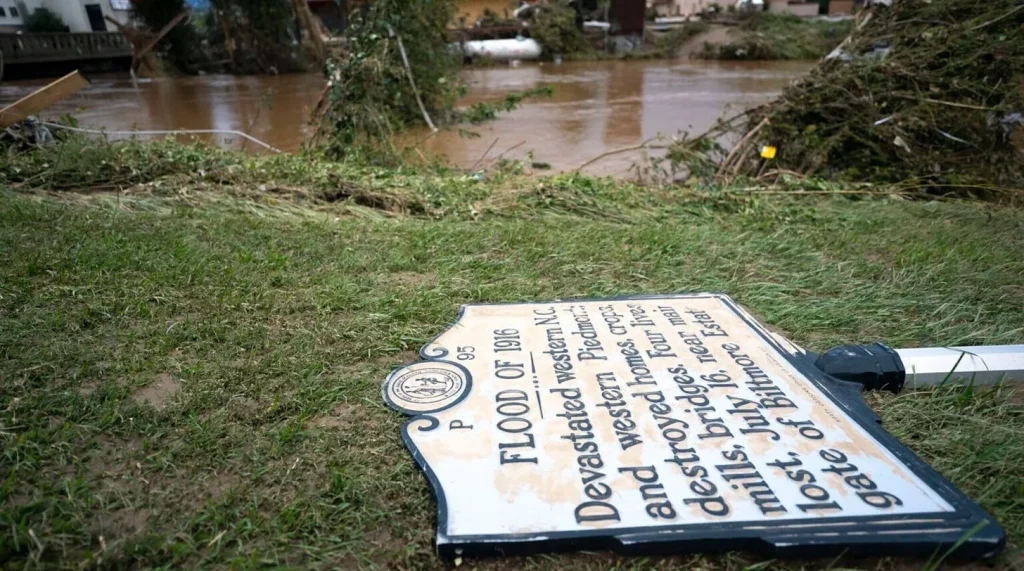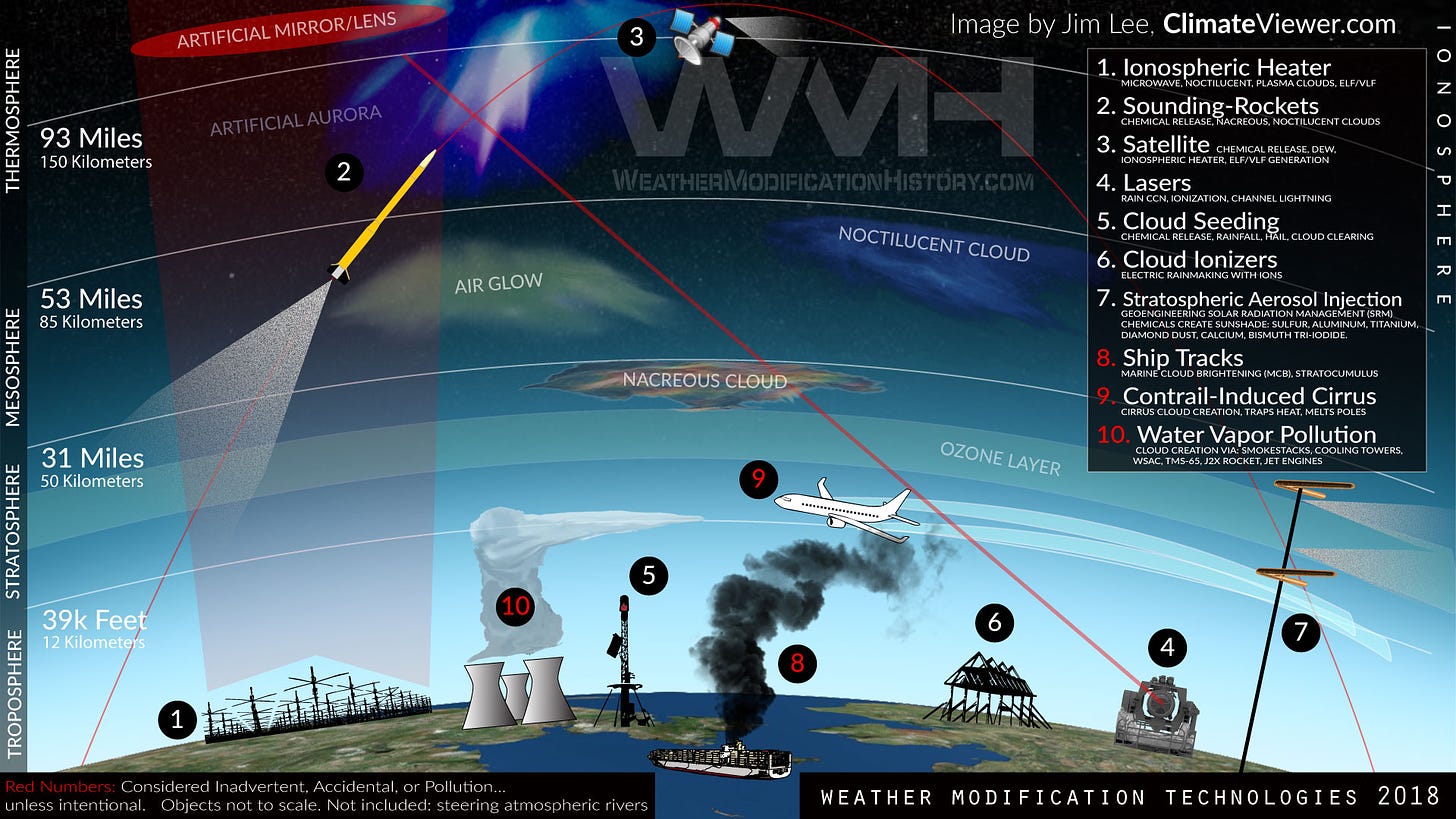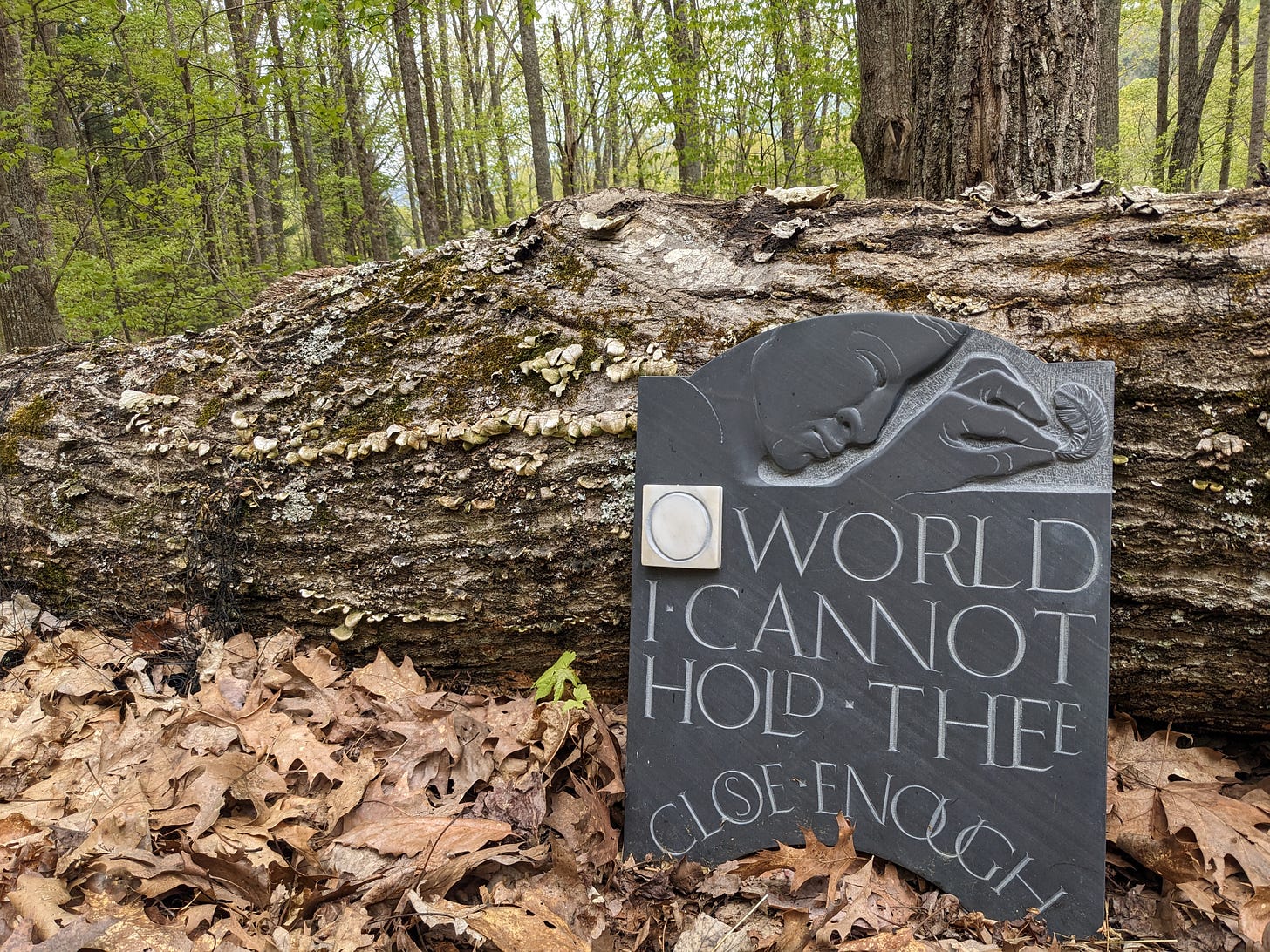“Whether the Weather”

Organic or not, I have to ask: Where is home? What is safety?
I’m still in shock.
I started this essay a little over a week ago because I couldn’t accept the pictures coming out of Western North Carolina.
My mind simply couldn’t square those images with my own photos from this past year, photos that seem so very wrong, now: my husband and me in Chimney Rock, wading in the very river that obliterated the town; or both of us on the Flower Bridge, home to the Rainbow Bridge, a place that welcomed collars of beloved passed pets, now gone.
Photo after photo provided evidence of our physical presence in places that now cling to existence: Asheville, Hendersonville, Burnsville, Spruce Pine, Boone, Bakersville, Blowing Rock, Black Mountain. Places I thought we might live. Places that seemed “away.”
It’s unimaginable.
I watched videos and read posts on X from people who attempted rescues, or people who were stranded, since the mainstream media was preoccupied with more important news.
I’m sure many of you have done the same.
There is so much grief mixed with disbelief that pours from these exhausted, traumatized people in their first-hand accounts. There is anger, too: palpable, justified. How could this have happened? Why is federal help coming so late? Why is FEMA impeding relief from volunteers?
My husband and I considered living in those towns — thus our many visits — because we saw them as viable high-ground options to hurricane-prone Florida. In fact, that area was considered a “climate haven.”
If you were to look at a map of WNC flood zones from flood.nc.gov you’d see almost every building in Asheville designated as “minimum risk”— even the ones right next to the French Broad River.
Who could ever imagine those beautiful towns vanishing overnight, swept away like undefended sandcastles? It’s the Blue Ridge Mountains, for god’s sake, not the lowlands. Who could imagine a water monster leaving its oceanic home and traveling more than 500 miles over land to terrorize mountain-dwellers?
No one. Especially the residents of WNC.
Far more imaginable is the damage that surrounded me in Florida, damage expected when you live near the coast.
During the past week and a half, I walked my neighborhood and witnessed its watery evisceration: house after house disgorging its ruined contents to the street. It’s so sad, to see mangled palisades of belongings — the result of someone’s effort and time and work to gather them into their homes — rising higher and higher, like the flood waters that destroyed them.
And now, Milton is on its way, this time heading straight for Tampa. After a day and a half of deliberation, we made the decision to evacuate.
We rolled up carpets, put the things we wanted to save up high, cut down some loose tree branches, brought in the potted plants and the patio furniture. I threw food in a cooler and grabbed what seemed to be the most important paper documents. Our windows aren’t hurricane-rated, and neither is our garage door, so who knows? We may come home to no house at all, or a flooded home (even though our house is at 15 feet of elevation, relatively high for Pinellas County), or minimal damage.
I’ve never evacuated a home before. It was beyond strange to take a last look around and wonder if it will still be standing when I return.
We (my husband, son and I) drove all night. Leaving the Tampa area was the hardest part; the traffic was at a standstill at times, and gasoline shortages almost made us turn around and go back. But we kept going, and by the grace of God, arrived in Charlotte, NC at 4am the next day.
I take in all of this chaos — all across the Southeast, in all its desperation and varying severity of destruction — and I want to understand. I want to know the truth.
Was this event really just an “act of God”? It’s possible. Ancient myths and accounts describe epic floods, certainly, and even more recently, at the turn of the last century, the worst flood in North Carolina history — “ The Great Flood of 1916” — caused widespread destruction and loss of life in Asheville and nearby river towns.
A plaque dedicated to that flood stood on the banks of the French Broad River until last week:

Yes, it’s possible that Helene did what she did organically, with no meddling. I am open to that possibility because who can definitively prove otherwise? And yet…
The part of me that came to life after 9/11 — when “the officials” at ground zero told my husband Peter to go back to work (a block and a half from ground zero) that the air was safe to breathe four days after 9/11, and he was diagnosed with leukemia two years later — has only strengthened since then. I now question everything.
Many of us do, now, as we should.
And so, in the past week, in addition to helping where I can in the neighborhoods around me, I dug into articles and websites created by others who’ve done years of immeasurable research on geoengineering (Jim Lee, Dane Wigington) or written incisively about that research (Dan Fournier). [Feel free to add other websites or names in the comments.]
They, and many others, have done a tremendous job of putting together compelling cases that argue for the involvement of governments in orchestrating — or enhancing — natural disasters. I highly recommend taking a look at what the three men above have compiled.
I’m not interested in convincing anyone of anything. I’m certain that some of my readers need no convincing; they’re already there. But I also know that some of my readers are on the other side of the fence, and others find themselves somewhere in the middle. I offer some research and material evidence I’ve come across in my own search for understanding, in the hope it will serve you in yours — or others you know in theirs.
“He who controls the weather, controls the world.”
— President Lyndon Johnson, 1962
Human beings have been interfering actively with the Earth’s atmosphere since the 1800s, and succeeding since the 1940s. As technology has exploded, so have advances in weather modification.
In the 1950s and 60s, governments all over the world were experimenting with weather manipulation. There was Project Stormfury, created by the U.S. military, and Operation Cumulus, a UK government initiative.
In 2001, Radio BBC broadcast this program investigating the 1952 Lynmouth flood disaster, a terrifying event that killed 35 people. The documentary asserts that the torrential storm — which dumped ninety million tons of rain overnight and swept the village out to sea — came only days after the Royal Air Force were conducting government rain-making experiments over southern England. Apparently, classified documents on the trials went missing.
Operation Cumulus was “put on hold indefinitely” after the tragedy.
A similar fate befell Project Stormfury in the U.S.:
“An attempt by the United States military to modify hurricanes in the Atlantic basin using cloud seeding in the 1960s was called Project Stormfury. Only a few hurricanes were tested with cloud seeding because of the strict rules that were set by the scientists of the project. It was unclear whether the project was successful; hurricanes appeared to change in structure slightly, but only temporarily. The fear that cloud seeding could potentially change the course or power of hurricanes and negatively affect people in the storm’s path stopped the project. [emphasis mine]
— from Freedom of Information Act (FOIA) requested by John Greenewald in March 2017
“…stopped the project.”
And yet, Operation Popeye, a secret military cloud-seeding program, was carried out by the U.S. Air Force during the Vietnam War from 1967 to 1972. Its objective was to extend the monsoon season over specific areas of the Ho Chi Minh Trail, thereby disrupting North Vietnamese military supplies.
In 1969, while Popeye was still classified, Admiral Pier Saint-Amand testified that he endorsed weather manipulation as a weapon, saying, “We regard the weather as a weapon. Anything one can use his way is a weapon and the weather is as good a one as any.”
Secretary of Defense Melvin Laird, in his 1972 testimony to the Senate, denied any weather modification in Northern Vietnam, saying “we have never engaged in that type of activity over Northern Vietnam .”
Yet in a letter he wrote to senators in January of 1974, Laird (no longer Secretary of Defense; now a special advisor to President Nixon) admitted that he lied to the Senate, and weather modification had, in fact, been undertaken in Vietnam. His excuse? He — as Secretary of Defense — didn’t know what was happening.
Based on all of the above, it seems more than likely that weather manipulation was “permanently stopped” in the same way gain-of-function research was “stopped.” Or torturing in Guantanamo. Or the MK Ultra program.
Expert after expert claims that cloud-seeding is nominally effective, yet the US, China, Russia, India, United Arab Emirates, Australia, Thailand, Switzerland, and Saudi Arabia still actively utilize the technology. Why spend hundreds of millions globally for something that doesn’t work?
In 1996, an Air Force-directed study entitled, Weather as a Force Multiplier: Owning the Weather in 2025 was completed to “examine the technologies the US will require to remain the dominant air and space force in the future.”
Given all that we know about government deception, is it far-fetched to imagine that governments are manipulating our living environments without our consent?
Here’s a simple 2018 infographic by Jim Lee of already-known and utilized technologies:

Even if you don’t believe that a hurricane could be “enhanced,” let’s say, made larger or directed by human interference, you have to admit that the Earth, like a human body, is a whole organism, a closed system. It’s not a machine, though like the human body, it’s often treated as such. It is an interconnected, living being that responds to everything that occurs within it.
We know that if you disturb one part of a forest — killing off the insects, for example — you can have a disastrous effect on the whole.
Leaving aside the geoengineering interference for the moment, what about everything else we do in the name of progress and convenience? Focusing solely on CO2 emissions seems woefully myopic when you consider all the additional ways we have been, and are still, messing with our ecosystem: strip mining, fracking, damming rivers, polluting air and waterways, urban sprawl, non-stop development, 5G cell towers, monoculture farming, destroying rainforests, cramming the atmosphere with satellites, landfills, pesticides, GMOs… it goes on and on and on.
If the “butterfly effect” has any validity at all, then by god, mightn’t we all agree that any catastrophic climate issue we experience could ultimately be laid at the feet of humankind’s arrogance, pursuit of power and dominance, and seemingly endless desire to bend the Earth to our own will? Who but a megalomaniacal entity — that has lost all perspective and humility — wants to own the weather?
I’m supremely fortunate. We were able to leave before Milton arrived, and we have the means to rent an Airbnb to wait it out. As I watch and wait, I pray for those who, for whatever reason, are sheltering in place.
I also think about the nature of the “truth” I’m seeking.
Truth is a word that inhabits two worlds. One is the factual description of practical, verifiable events: “This happened because eyewitnesses saw it, or even better, I saw it, thus I know it to be true.”
Then there’s truth, something that resonates deep within us as an archetypal affirmation of higher validity. It has its roots in Plato’s absolute forms: those principles that exist outside experience and time, that are universal and unchanging.
Those two types of truth occasionally intersect, but for the most part they exist independently. Facts don’t necessarily correlate with wisdom, though wisdom often incorporates facts.
As I have dug deeper into geoengineering, sifting and searching for material truth, the more I realize that I’m craving both.I’m seeking practical answers to physical life on this planet, yes: Why is this happening? Could it be manmade? Is it on purpose? If it is, how can we reclaim our planet from those power-drunk forces? If it isn’t, how can we return to a relationship with the Earth that truly honors her wholistic nature?
I’m also seeking higher, deeper truths. Something eternal. Like: Where is home? What is safety?
Since we human beings bridge earth and heaven, we have both earthly answers and heavenly answers to all of those questions. And right now, for thousands and thousands of individuals who have suffered and continue to suffer from Helene’s destruction, and may suffer from Milton’s, it’s the earthly answers that matter most. As many have said, “thoughts and prayers” ring pretty hollow when there’s no potable water.
Compassionate individuals are making it their mission to help their neighbors, everywhere, including here. I’ve seen sandwiches and spaghetti dinners appear out of minivans; I’ve seen people of all stripes volunteer, donate, and roll up their sleeves. The small store where I work part-time made available free sourdough bread and handmade soap for those in need.
Communities are forming where none existed before. Houses have been and will be destroyed, yes, but connection and trust are building. This is what human beings do. We build. We hug. We come together in crisis.
And we pray, too, which may not have the tangible effect that those who are suffering need most… but it matters.
Plugging into the unseen world of love and residing there, holding departed or suffering souls in that heart-light, asking for help from the spiritual world… do make a difference. Everything we do matters, including energetically. For those who are far from the devastation, it may be the only thing we can do.
“Home” and “safety” are not just earthly necessities; they’re also spiritual states of being. Our true home is not of this Earth. We are safe, always, in a way that is ineffable. That lesson is being pressed on so many of us now. I feel it keenly.
During Peter’s and my search for a home in WNC, we looked at a house in Bakersville, nestled in the mountains. It was owned by an artist, Collene Karcher, a stonecutter who could no longer live in the unusually tall house with spiral staircases.
Her beautiful home didn’t work for us, but her artwork sure did. It liberally dotted the steeply sloping land, and it enchanted me. With chisel and hammer — old school tools of the trade — she carves words and images into stone. This one, with the first sentence of an Edna St. Vincent Millay poem, took my breath away:

Here is the poem:
God’s World
O world, I cannot hold thee close enough!
Thy winds, thy wide grey skies!
Thy mists, that roll and rise!
Thy woods, this autumn day, that ache and sag
And all but cry with colour! That gaunt crag
To crush! To lift the lean of that black bluff!
World, World, I cannot get thee close enough!Long have I known a glory in it all,
But never knew I this;
Here such a passion is
As stretcheth me apart,—Lord, I do fear
Thou’st made the world too beautiful this year;
My soul is all but out of me,—let fall
No burning leaf; prithee, let no bird call.—Edna St. Vincent Millay
Millay doesn’t speak of idyllic nature, of daisies and calm meadows. She describes a nature that is almost forbidding: grey skies and winds, woods that ache and sag, a gaunt crag to crush. Her nature, our nature, is wild and primeval, full of power and mystery.
Her nature is not safe.
We are here to hold that nature close to us, to press ourselves into its hard-edged fury and still marvel at its beauty, even as it stretches us apart. We are asked to embrace all of this life, all of it, even when it threatens to annihilate all that we hold dear. That is where safety — the omnipresent one, the loving one, the ineffable one — resides.
Finally, the truth I’ve been seeking. May I have the courage to live it.
Blessings to all who are facing the seemingly insurmountable.
As always, keep your light shining bright.
xox
M
_____________
Follow DailyClout on Rumble! https://rumble.com/user/DailyClout
Please Support Our Sponsors
Birch Gold Group: A Gold IRA from Birch Gold Group is the ultimate inflation hedge for your savings in uncertain times. To see how to protect your IRA or 401(k), get your FREE info kit on gold by texting the word “DAILYCLOUT” to 989898
The Wellness Company: https://dailyclouthealth.com
Use code DAILYCLOUT for 10% off!
NativePath: Collagen supplements help you replace what you stop producing — and the studies speak for themselves. Visit https://getnativepath.com/dailyclout for a MASSIVE 45% discount plus free shipping!
BiOptimizers: Over 75% of the population is magnesium deficient. Nurture your mind and body with this all-natural, full-spectrum magnesium supplement. Go to bioptimizers.com/dailyclout and use promo code DAILYCLOUT for 10% off!
Order ‘The Pfizer Papers’ and Support Our Historic Work: https://www.skyhorsepublishing.com/9781648210372/the-pfizer-papers/
Discover LegiSector! Stay up-to-date on issues you care about with LegiSector’s state-of-the-art summarizing capabilities and customizable portals. No researchers needed, no lobbyists, no spin. Legislation at your fingertips! Learn more at https://www.legisector.com/
One of our country’s most important freedoms is that of free speech.
Agree with this essay? Disagree? Join the debate by writing to DailyClout HERE.




